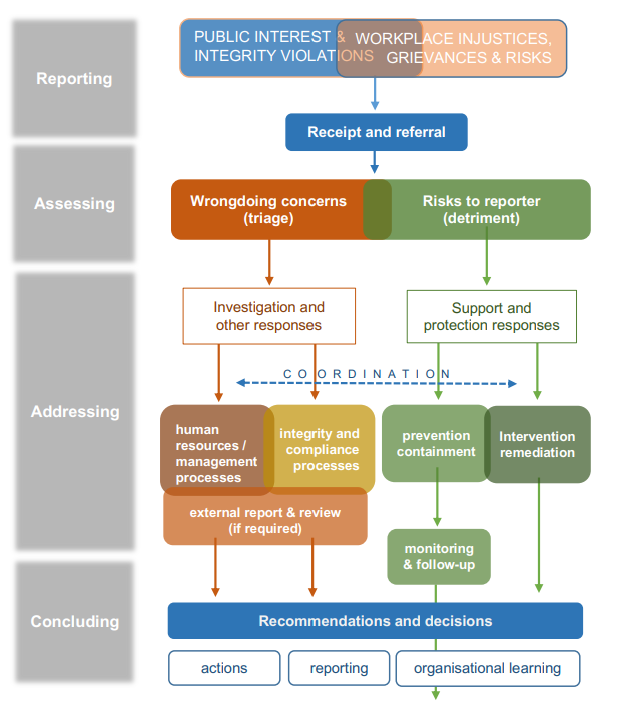In today’s blog post:
- The origins of “clean as a whistle”
- Famous whistleblowing incidents
- Whistleblowing is not only for big companies
- Who is a whistleblower under the law?
- Way We Do Templates: Whistleblower Policy and Whistleblower Investigation and Disciplinary Process
- An international standard for Whistleblowing Management Systems
- A Step-by-Step Process for Managing a Whistleblower Report
Clean as a Whistle
The origins of the phrase “clean as a whistle” are uncertain, but there are a few theories. One theory is that it derives from the fact that whistles are often made of metal, which is a naturally clean material. Another theory is that the phrase refers to the sound of a whistle, which is often described as being clear and pure.
The phrase “clean as a whistle” means “completely clean” or “free from dirt or impurities.” It can be used to describe both physical objects and abstract concepts such as a person’s or business’ reputation. For example, you might say that a person’s reputation is “clean as a whistle” if they have never been accused of wrongdoing.
From a whistleblower’s perspective, the phrase “clean as a whistle” takes on a whole new meaning.
In the world of corporate fraud and corruption, “clean as a whistle” is often used to describe a company or individual who appears to be above reproach. However, as whistleblowers may know, this is not always the case.
Behind the gleaming facade of many seemingly “clean” companies, there can be a hidden world of illicit activities, such as accounting fraud, bribery, and environmental violations. The perpetrators of these crimes often go to great lengths to cover their tracks and maintain the illusion of innocence.
Criminals can manipulate the system and evade detection for years. They use their wealth and influence to silence critics and intimidate those who would expose their wrongdoing.
The phrase “clean as a whistle” is a reminder that appearances can be deceiving. It is a warning to be wary of those who claim to be above reproach and to always question the status quo.

Source: Griffith University, Whistling While They Work
Famous whistleblowers
We see reports of whistleblowing in the news all the time. Edward Snowden‘s disclosure of classified information from the National Security Agency (NSA) in 2013 is an example of a famous whistleblowing incident.
Some other famous whistleblowing incidents include:
- Daniel Ellsberg leaking the Pentagon Papers in 1971, which exposed the U.S. government’s deception about the Vietnam War.
- Frank Serpico exposing corruption in the New York City Police Department in the 1970s.
- Cynthia Cooper revealing the accounting fraud at WorldCom in 2002.
- Sherron Watkins warning Enron executives about the company’s accounting irregularities in 2001.
- Bradley Manning leaking classified military and diplomatic documents to WikiLeaks in 2010.
Whistleblowing can be a risky act, as whistleblowers may face retaliation from their employers or others who are implicated in the wrongdoing. However, whistleblowers can also play a vital role in exposing wrongdoing and holding powerful individuals and organizations accountable.
Whistleblowing is not only for big companies
Whistleblowing can occur in any type of organization, regardless of size or industry. In fact, whistleblowing is often more important in smaller companies, where there may be fewer checks and balances in place to prevent wrongdoing.
Some examples of whistleblowing in small companies include:
- An employee of a small accounting firm discovers that the company is falsifying financial statements.
- A worker at a small factory notices that the company is dumping hazardous waste illegally.
- A salesperson at a small retail store realizes that the company is selling defective products to customers.
In each of these cases, the whistleblower is exposing wrongdoing that could have a significant impact on the public. Whistleblowing can help to protect consumers, employees, and the environment, regardless of the size of the company involved.
Who is a Whistleblower Under the Law?
A whistleblower is an individual who discloses information about wrongdoing, typically to a supervisor, government official, or the media. Whistleblowers often expose illegal or unethical activities, such as fraud, corruption, or environmental violations.
In many countries, there are laws in place to protect whistleblowers from retaliation. These laws vary from country to country, but they typically provide some form of legal immunity to whistleblowers who report wrongdoing in good faith.
Some examples of whistleblower laws include:
- The Whistleblower Protection Act of 1989 (USA)
- Public Servants Disclosure Protection Act (PSDPA) 1996 (Canada)
- The Public Interest Disclosure Act 1998 (UK)
- The Whistleblower Protection Directive (EU) 2019/1937
- Public Interest Disclosure Act 2013 (Australia)
- Protected Disclosures Act 2000 (New Zealand)
These laws define who is considered a whistleblower under the law. In general, a whistleblower is someone who:
- Discloses information about wrongdoing to a supervisor, government official, or the media
- Has a reasonable belief that the information they are disclosing is true
- Is not acting out of personal gain or malice
According to the information provided, an individual is not considered a whistleblower under the law if they:
- Disclose information about wrongdoing for personal gain or malice.
- Do not have a reasonable belief that the information they are disclosing is true.
- Do not disclose information about wrongdoing to a supervisor, government official, or the media.
Whistleblowers play a vital role in exposing wrongdoing and holding powerful individuals and organizations accountable. However, they often face retaliation from their employers or others who are implicated in the wrongdoing. Whistleblower protection laws help to protect whistleblowers from retaliation and encourage them to come forward with information about wrongdoing.
How to Foster a Culture Where People Feel Comfortable Coming Forward as Whistleblowers
Creating a culture where employees feel comfortable coming forward as whistleblowers is essential for uncovering wrongdoing and protecting the public interest. Here are some key steps organizations can take to foster such a culture:
- Establish a Clear Policy: Develop a comprehensive whistleblower policy that outlines the organization’s commitment to protecting whistleblowers and the procedures for reporting wrongdoing.
- Communicate the Policy: Communicate the whistleblower policy to all employees through training, intranet, and other internal communication channels.
- Protect Confidentiality: Assure whistleblowers that their identities will be kept confidential to the fullest extent possible.
- Provide Multiple Reporting Channels: Offer multiple reporting channels, such as a hotline, email, and in-person reporting, to make it easier for employees to come forward.
- Train Employees on Ethical Behavior: Conduct regular training on ethical behavior and the importance of whistleblowing.
- Encourage Open Communication: Create an open and transparent culture where employees feel comfortable speaking up about concerns.
- Investigate Reports Promptly: Investigate whistleblower reports promptly, thoroughly, and impartially.
- Protect Whistleblowers from Retaliation: Implement strong anti-retaliation policies and procedures.
- Recognize and Reward Whistleblowers: Recognize and reward whistleblowers for their courage and contribution to the organization.
- Evaluate and Improve Continuously: Regularly review and improve the whistleblower program to ensure its effectiveness
By fostering a culture of transparency, integrity, and accountability, organizations can create an environment where employees feel safe and empowered to report wrongdoing. Remember, whistleblowers play a crucial role in safeguarding ethical standards and upholding the principles of justice and fairness. By effectively managing whistleblower reports, organizations can not only protect their reputation but also contribute to a more transparent and accountable society.
New Way We Do Templates: Whistleblower Policy and Whistleblower Investigation and Disciplinary Process
The Way We Do Marketplace library provides several templates that can help organizations develop and implement effective whistleblower policies and procedures. These templates include:
- Whistleblower Policy: This template provides a comprehensive framework for organizations to establish a whistleblower policy. Your policy may include guidance on the following:
- The definition of whistleblowing
- The types of wrongdoing that are covered by the policy
- The procedures for reporting wrongdoing
- The protections that are available to whistleblowers
- The consequences for retaliating against whistleblowers
- Whistleblower Investigation and Disciplinary Process: This template provides a step-by-step process for organizations to follow when investigating reports of wrongdoing. It includes guidance on the following:
- How to receive and acknowledge reports of wrongdoing
- How to conduct an investigation
- How to take appropriate action based on the findings of the investigation
- How to protect whistleblowers from retaliation
These templates can be customized to meet the specific needs of any organization. They can be used to create a comprehensive whistleblower protection program that helps to protect employees, customers, and the public from wrongdoing.
By using these templates from the Way We Do Marketplace library, organizations can save time and money while developing and implementing effective whistleblower policies and procedures.
An international standard for Whistleblowing Management Systems
The international ISO standard for whistleblowing is ISO 37002:2021 Whistleblowing Management Systems. This standard provides guidance on establishing, implementing, maintaining, and improving a whistleblowing management system. It helps organizations create a culture of openness and transparency, where employees feel safe to report wrongdoing without fear of retaliation. ISO 37002:2021 is applicable to organizations of all sizes and types, regardless of their industry or location and is built upon 3 principles – trust, impartiality, and protection.
Whistleblowers who are employees generally report the issue internally first via agreed upon reporting channels. It gives organizations a chance to investigate and correct any wrong doing and poor conduct. However, reporting is only the beginning step of this process. The process also incorporates Investigating, Taking Action, and Protecting the whistleblower.
Employees need to have trust in the system, otherwise they will not come forward
Organizations should adopt a comprehensive approach that encompasses a wide range of concerns that may trigger the Whistleblower Policy. This proactive stance ensures that all pertinent issues are identified, acknowledged, and appropriately addressed, leaving no stone unturned.
One third of whistleblower reports are related to industrial or workplace concerns, while 47% include a combination of public interest and workplace issues. This evidence supports the need for having a Whistleblower Policy and process in the workplace.
A Step-by-Step Process for Managing a Whistleblower Report
 Source: Griffith University, Whistling While They Work
Source: Griffith University, Whistling While They Work
- Receive the report. This can be done through a variety of channels, such as a hotline, email, or in person.
- Acknowledge the report. Let the whistleblower know that their report has been received and is being taken seriously.
- Assess the report. Triage the wrongdoing concerns and conduct a risk assessment to understand if there are any detrimental impacts for the reporter.
- Investigate the report. This should be done promptly and thoroughly. The investigation should be conducted by an independent party to ensure impartiality.
- Protect the whistleblower. Whistleblowers should be protected from retaliation. This may include providing them with anonymity, legal assistance, and counseling.
- Take appropriate action. If the investigation finds that there is evidence of wrongdoing, appropriate action should be taken. This may include disciplinary action against employees, changes to policies and procedures, or reporting the matter to law enforcement.
- Track and Monitor. Reports need to be tracked in a systematic manner including status, progress of agreed actions, and following up with the reporter.
- Evaluate the effectiveness of the whistleblower program. The whistleblower program should be evaluated and reported upon regularly to ensure that it is effective and is meeting the needs of the organization.





